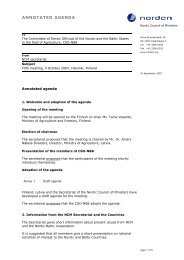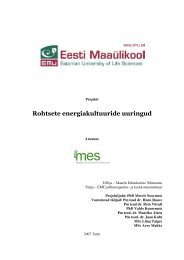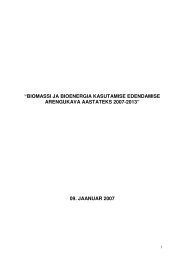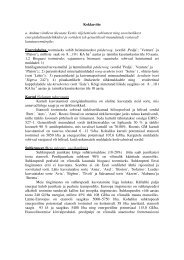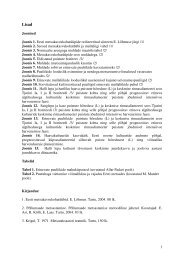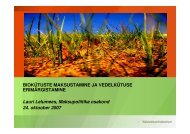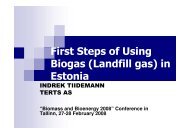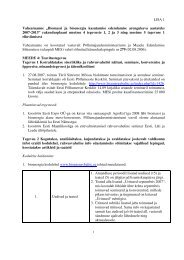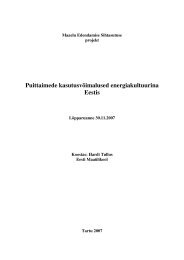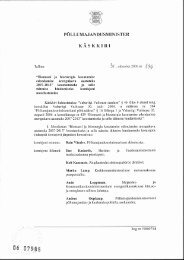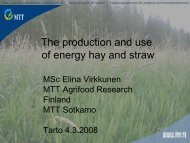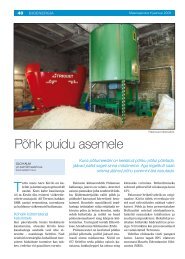Thermal use of agricultural biomass (PDF) - bioenergybaltic
Thermal use of agricultural biomass (PDF) - bioenergybaltic
Thermal use of agricultural biomass (PDF) - bioenergybaltic
Create successful ePaper yourself
Turn your PDF publications into a flip-book with our unique Google optimized e-Paper software.
BOVA course“Energy Crops and Biogas Production”3-7 March 2008 in Tartu<strong>Thermal</strong> <strong>use</strong> <strong>of</strong> <strong>agricultural</strong> <strong>biomass</strong>M. WachendorfDepartment <strong>of</strong> Grassland Scienceand Renewable Plant ResourcesUniversity <strong>of</strong> Kasselemail:web:mwach@uni-kassel.dewww.agrar.uni-kassel/gnrDepartment <strong>of</strong> Grassland Scienceand Renewable Plant Resources
Water content 45-60% in fresh wood (type <strong>of</strong> tree/wood harvest time); reduction <strong>of</strong> net energy yield(exeption: furnace utilising condensation energy) Storage losses above 16% through biodegredation and transformation; firehazard with grasslandHeating value Heating value (HV) strongly affected by water content (usually based onwater (and sometimes ash-) free DM Wodden solid fuels are 9% higher in HV than cereals, hay and straw, as theycontain more lignin and extracts Thumb rule: 2.5 kg DM wood ≈ 1 l fuel oil ≈ 10kWh ≈ 36 MJ HV <strong>of</strong> dry <strong>biomass</strong> is correlated with contents <strong>of</strong> oxidisable elements (mainlyC, H and S, N) => approximation <strong>of</strong> HV by elemental constitution:HV waterfree(MJ/kg) = 34.8 C + 93.9 H + 10.5 S + 6.3 N - 10.8 O (after BOIE)Department <strong>of</strong> Grassland Scienceand Renewable Plant Resources
Heating value (continued) HV depends on ashcontentType <strong>of</strong> BiomassHeatvalueH l (wf)MJ/kgHeatvalueH u (wf)MJ/kgAsh Volat.content compon.(wf) (wf)in % DMin % DMAsh s<strong>of</strong>tening behaviourHard coalLigniteSpruce woodBeech woodPoplar woodWillow woodBarkRye strawWheat strawTriticale strawBarleyRapeseed strawMaize strawSunflower strawHemp strawRye WCSWheat WCSTriticale WCSRye grainWheat grainTritical grainRapeseed grainMiscanthusNature conservation hayFestuca arundinaceaeIntensive grasslandDitch cutDepartment <strong>of</strong> Grassland Scienceand Renewable Plant Resourcesa SB: start <strong>of</strong> sintering; EP: s<strong>of</strong>teing point; FP: flowing pointbwater content <strong>of</strong> hard coal 5.1%; lignite 50.4%
Heating value (continued)WoodHeating valueKS, Abb. 8.8Grasses etc.(% <strong>of</strong> DM)Ash content(Kaltschmitt, 2001)Department <strong>of</strong> Grassland Scienceand Renewable Plant Resources
Upper heating value Upper heating value (HV u) ≈ 8% higher than HV During cooling <strong>of</strong> flue gases condensation <strong>of</strong> water vapour adds to theenergy yieldEnergy yield based on H uEnergy yieldbased on H lHeating valuesH lH uEnergy yield(Kaltschmitt, 2001)Water contentWeight <strong>of</strong> solid fuel at 1 kg DMDepartment <strong>of</strong> Grassland Scienceand Renewable Plant Resources
Nitrogen Occurs in <strong>biomass</strong> proteins, amines, and NPN constituents Is totally transformed into the gaseous phase during combustion NO x-formation is correlated with N content <strong>of</strong> <strong>biomass</strong> Manipulation through:- Choice <strong>of</strong> species and developing stage <strong>of</strong> crops- Addition <strong>of</strong> O in furnace- Catalysts (NH radical to reduce N to N 2)Department <strong>of</strong> Grassland Scienceand Renewable Plant Resources
NitrogenConventional combustionAddition <strong>of</strong> OUse <strong>of</strong> catalyst (SNCR)StrawGrassMiscanthusRest woodWoodChipboardUse <strong>of</strong> catalyst (SCR)N content in solid fuel(Kaltschmitt, 2001)Department <strong>of</strong> Grassland Scienceand Renewable Plant Resources
Properties <strong>of</strong> <strong>biomass</strong> as relevant for combustionType Biomass <strong>of</strong> BiomassHard coalLignite% <strong>of</strong> DMSpruce woodBeech woodPoplar woodWillow woodBarkRye strawWheat strawTriticale strawBarleyRapeseed strawMaize strawSunflower strawHemp strawRye WCSWheat WCSTriticale WCSRye grainWheat grainTritical grainRapeseed grainMiscanthusNature conservation hayFestuca arundinaceaeIntensive grasslandDitch cutDepartment <strong>of</strong> Grassland Scienceand Renewable Plant Resources(Kaltschmitt, 2001)
Potassium (Sodium) K mainly in vegetative parts <strong>of</strong> plants (=> Wheat grain) Variability in straw is due to fertilisation and leaching after harvest (=> greystraw) Both facilitate corrosion <strong>of</strong> furnace: K => alkaline chlorides => K sulphateduring condensation on heat changer => Free Cl 2=> FeCl on furnace wallSulphur Easily volatile; few knowledge on integration in ash Low contents in cereals => no measures for reduction necessaryChlor HCl concentration during combustion <strong>of</strong> grass: 20-120 mg/Nm³ (target value<strong>of</strong> 30 only possible by means <strong>of</strong> separation (e.g. washer)Department <strong>of</strong> Grassland Scienceand Renewable Plant Resources
Pathways <strong>of</strong> <strong>biomass</strong> K, Cl und S through the furnacesolidsolid=> Low separation in cyclones, high in fabric filter(Kaltschmitt, 2001)Department <strong>of</strong> Grassland Scienceand Renewable Plant Resources
Properties <strong>of</strong> <strong>biomass</strong> as relevant for combustionBiomass Type <strong>of</strong> BiomassHard coalLignite% <strong>of</strong> DMSpruce woodBeech woodPoplar woodWillow woodBarkRye strawWheat strawTriticale strawBarleyRapeseed strawMaize strawSunflower strawHemp strawRye WCSWheat WCSTriticale WCSRye grainWheat grainTritical grainRapeseed grainMiscanthusNature conservation hayFestuca arundinaceaeIntensive grasslandDitch cutDepartment <strong>of</strong> Grassland Scienceand Renewable Plant Resources(Kaltschmitt, 2001)
Heavy metals Heavy metals (HM) are tranformed into the gaseous phase withtemperatures <strong>of</strong> 800 to 1100 °C in the furnace During cooling-down <strong>of</strong> flue gas vapours condensate on fine particles=> Furnace ashes are low, separator ashes are high in heavy metalconcentrationHeavy metal concentration(mg/kg DM)straw whole crops bark chopped Higher contents in wood ca<strong>use</strong>d by:- increased dry and wet deposition <strong>of</strong> HM in forests- growth periods <strong>of</strong> 70 to 120 years facilitate HM accumulation in wood- soil pH in forests lower than on arable land => increased solubility <strong>of</strong> HMDepartment <strong>of</strong> Grassland Scienceand Renewable Plant Resources
Ash content and s<strong>of</strong>tening pointT ep= 1172 - 53.9 * K + 252.7 * Ca - 788.4 * Mg0% Mg 0.4% Mg 0.8% Mg200020002000160016001600120012001200TepTepTep8008008004004002.44002.42.41.81.81.8000.81.62.4K3.244.85.601.20.6Ca000.81.62.4K3.244.85.601.20.6Ca000.81.62.4K3.244.85.601.20.6Ca Increase <strong>of</strong> T epthrough the addition <strong>of</strong>- calcium containing amendments (lime)- alkaline-binding amendments (Kaolin)- leaching during field phase (straw, hay)Department <strong>of</strong> Grassland Scienceand Renewable Plant Resources
Mineral composition <strong>of</strong> grassland speciesg kg -1 TMmg kg -1 TMPflanzengruppeCaPMgNaKFeMnCuZnGrasses Holz4,3 3,03,0 0,51,8 0,5o.N. 0,120,0 1,5o.N. 60o.N. 60o.N. 7o.N. 25Legumes Gräser17,0 4,34,5 3,04,5 1,80,4 0,135,0 20,0110 6055 6012 735 25Herbs15,05,54,10,322,090409,025(Kaltschmitt, 2001; Haiger et al., 1988)Department <strong>of</strong> Grassland Scienceand Renewable Plant Resources
Fine particulatesFine particulate emmissionK, Cl, S concentration in the fuel (% <strong>of</strong> DM)GrassStrawGrassStrawMiscanthusMiscanthus(Kaltschmitt, 2001) Target value <strong>of</strong> 150 mg/Nm³ is <strong>of</strong>ten exceeded=> Separation <strong>of</strong> fine particulates is mandatory (Cyclone, fabric andelectrostatic precipitators, washerDepartment <strong>of</strong> Grassland Scienceand Renewable Plant Resources
λλλλCereal crop compatible incinerators Due to problematic properties <strong>of</strong> crops- complex technique necessary- not a common fuel for small private furnaces Controlled supply <strong>of</strong> air into the furnace= m Luft,total/ m Luft,min= air excess valuem air,total: Total quantum <strong>of</strong> air fed into the furnacem air,total: Minimum quantum <strong>of</strong> air necessary for complete oxidation( >1: full oxidation (usually 1.5 to 2.5); 0<
λCereal crop compatible incineratorsprobethermistorsuction fancombustionzoneflue gasheat changersolid fuelashautomaticignitionflue gascombustion gasash pusherfancombustionmouldIncinerator for bulk goods (e.g. straw pellets, chopped material, residues fromseed production, broken grains, milling residues; 49 kW)Department <strong>of</strong> Grassland Scienceand Renewable Plant Resources
Cereal crop compatible incineratorsfeeding gateheat changersecondaryair supplywater-cooledwallfanIncinerator for straw bales (continuously and discontinuously; above 85 kW)German emission regulations do not allow such furnaces (CO, fine particles)Department <strong>of</strong> Grassland Scienceand Renewable Plant Resources
Flue gas cleaning by cyclonesRotational motion creates centrifugal force Separation <strong>of</strong> particles <strong>of</strong> 2-5mThe grade <strong>of</strong> separation can be improved by installing several cycloneswithin one casingScheme <strong>of</strong> a cyclone and multi cycloneraw gas(tangentialentry)piperaw gas(tangentialentry)clean gasclean gascasecentralupstream vortexconeto the bunkersrew conveyerDepartment <strong>of</strong> Grassland Scienceand Renewable Plant Resources(Kaltschmitt, 2001)
Flue gas cleaning by washersWetting <strong>of</strong> particles by water dropletsDownstream separator e.g. cycloneHigh energy demand depending on the level<strong>of</strong> cleaningPrinciple <strong>of</strong>Venturi washer1. raw gas entry2. clean gas exit3. feeding <strong>of</strong> washliquid(Kaltschmitt, 2001)Department <strong>of</strong> Grassland Scienceand Renewable Plant Resources
Flue gas cleaning by electrostatic precipitatorParticle motion is ca<strong>use</strong>d bynegative charging in a strongelectromagnetic fieldCleaning <strong>of</strong> precipitationelectrode (anode) throughbeatingHighest degrees <strong>of</strong> precipitationeven for fine particulatesspraying electrodeOperation <strong>of</strong> electrostatic precipitatorselectroneparticulatecharged precipitatedprecipitationelectrode(anode)neutral ionizedgas moleculesDepartment <strong>of</strong> Grassland Scienceand Renewable Plant Resources(Kaltschmitt, 2001)
Flue gas cleaning by fabric filtersfiltering through sieving effectsand mutual particle adhesionmade <strong>of</strong> screen cloths,ceramics, metallsnote flying sparksCross section <strong>of</strong> a fabric filterelectronedusting downprocedurefilteringproceduresupportingcagefiltermediumDepartment <strong>of</strong> Grassland Scienceand Renewable Plant Resources(Kaltschmitt, 2001)
Degree <strong>of</strong> flue gas cleaningFabric filterDegree <strong>of</strong> flue gas cleaningElectromagneticfilterVarioustypes<strong>of</strong>washerCycloneParticle size(Kaltschmitt, 2001)Department <strong>of</strong> Grassland Scienceand Renewable Plant Resources



